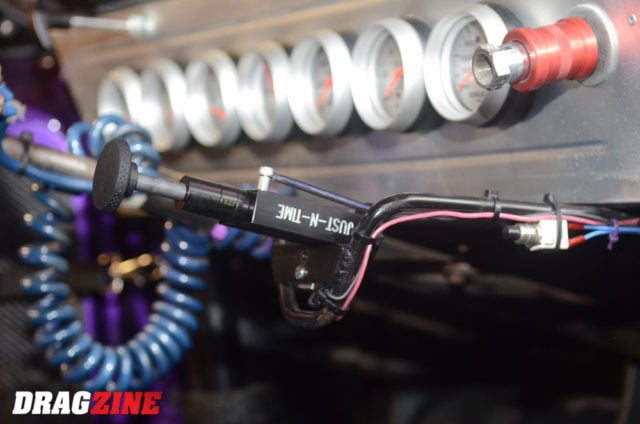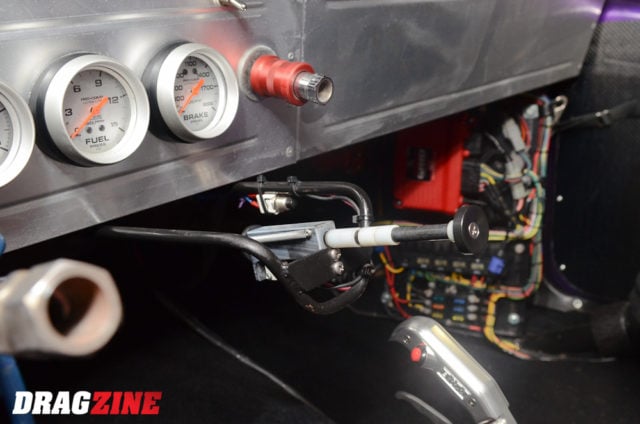Despite all of the time, effort, and money we pour into our racing machinery chasing performance and consistency, half of the drag racing equation lies in the first milliseconds of any race. Reaction time, while pivotal in heads-up contests, is unequivocally do-or-die in the bracket and index racing world, and just as gearheads have leveraged technology to gain an edge on the scoreboard since the very beginning, so too have resourceful competitors in improving their performance on the christmas tree.
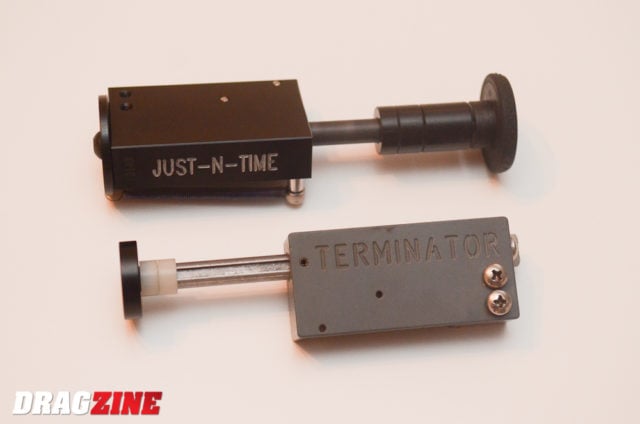
The Just-N-Time button from CollectorTethers.com (top) and the tried-and-true Terminator button from Biondo Racing Products.
Seasoned bracket racers who have honed their craft almost to the point of obsession are able to produce repeatable reaction times run after run, often within thousands of a second of one another (and they know when they’re a couple ‘thou’ late, too). But, when you introduce outside factors — the brightness of a given tracks’ bulbs, the ambient lighting, the racing surface and how the car reacts to it, air conditions that cause the car to react quicker or slower, and even the drivers’ physical and mental state on a given day — variances in reaction time come to exist. And when a racer is truly locked-in with their “spot” on the tree, mentally adjusting on the fly is easier said than done.
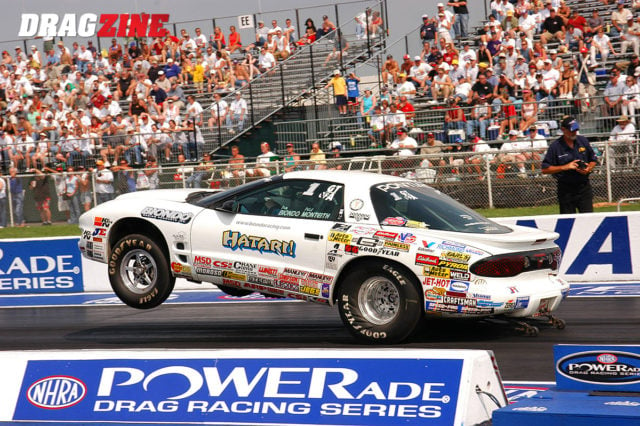
Peter Biondo, one of sportsman drag racing’s most feared wheelmen, has won a pair of world titles and countless races with his company’s Terminator button.
For about half of the bracket and index racers in the sport, the advent of the delay box solved that very problem, allowing the driver to adjust the point at which the car will launch off the starting line, without having to alter their actual release point on the tree. But for those who can’t run a delay box — often referred to at local strips as the “Pro” or “No Box” class — that isn’t an option. So how did they get around it? They started looking at the buttons.
Now, competitive No Box racers don’t bring just a spare set of spark plugs with them to the track; they’re also carrying a variety of transbrake buttons, or, at the very least, one highly adjustable button in the car to get them through any scenario and remain in the double-o’s.
How They Work
Unlike traditional transbrake buttons used by delay box racers, the hallmark of these adjustable buttons for bottom bulb racers is the extra-long “throw” of the button. Per NHRA regulations for Super Stock and Competition Eliminator, buttons are permitted to have a maximum of three-inches of travel. The rules vary in other bracket racing venues, and in some cases there are no restrictions at all, but as we’ll get into in the next section, the mass-produced buttons on the market today are largely made with NHRA regulations in mind.
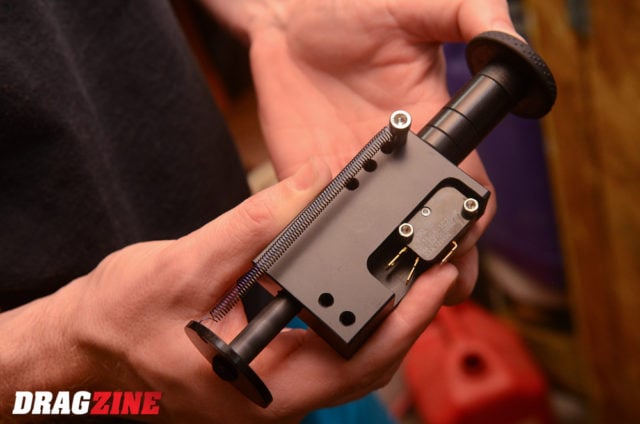
The Just-N-Time button is one of the newer offerings on the market, offering a considerable degree of adjustability through the interchangeable springs and shims.
Each of the buttons, as we’ll pinpoint below, is adjustable through a few different means; most utilize a spring or series of springs built into the design that can be interchanged to alter the rate of return of the button. Most of the buttons also use a supplied set of shims that shorten the “throw” of the button, or in essence its rate of extension after the release that signals the transmission to release the transbrake and launch the car. The two adjustment parameters combined to allow the driver to hone in on a specific amount of “delay.”
In essence, these are a mechanical and perhaps rudimentary means of replicating what a delay box does. While some might argue that it’s less precise than dialing numbers in and out of a delay box, once you understand how deadly bottom bulb racers can be on the tree, such adjustment methods in the right hands are in fact incredibly accurate.
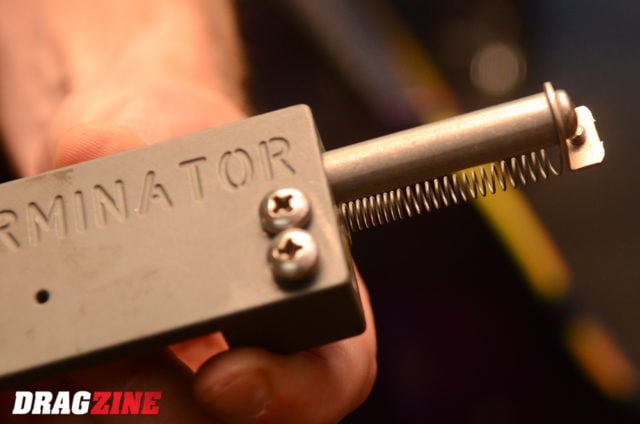
The Terminator button features an internal spring, with the adjustments made through the shims on the button shaft.
The Options
Two of the more popular buttons on the market at present are the “Terminator” from Biondo Racing Products, home to world champion racers Peter and Sal Biondo, and the Just-N-Time Button from CollectorTethers.com, owned by accomplished sportsman racers Lynn Ellison and Scott Lemen. Others include the “5-0” button from Phil Mandella Race Cars (who is believed to have been the first to market and sell a long throw-style button) and the appropriately named “Sloooow Release” transbrake button from Apex Machining Co. There are also, as you might imagine, a whole slew of one-off, homemade buttons out there of all different designs, button faces, and travel length.
Peter Biondo, one of the most accomplished sportsman drag racers in history, has won a pair of world championships in Super Stock with the Terminator button — aptly given its name from the “Terminator” moniker he’s been bestowed by his fellow racers — and countless others have driven to victory circle with one in their cars, including Dan Fletcher, Justin Lamb, and brother Sal Biondo. The Terminator is perhaps still the most popular button on the market, utilizing an internal spring to prevent binding of catching, with seven shims providing about .005-seconds worth of adjustment each (Biondo provides a tip sheet for shim addition/removal to achieve a given delay). The button has a maximum delay of .045-seconds.
…we went through many springs and a lot of testing and we found what we’re selling now is the happy medium between what you can get with three inches of travel without losing any reliability. – Peter Biondo
“When we initially came out with the Terminator, we went through many springs and a lot of testing and we found what we’re selling now is the happy medium between what you can get with three inches of travel without losing any reliability. There are different ways of mounting it, and that does come into play a little bit, but it’s hard to get a lot more delay, especially in a racecar with a lot of vibration that could very well re-engage the button if you have a weak spring. We feel like we have a good handle on it, and we did a lot of testing in its development.”
The internal spring in the Terminator can be interchanged by the user, but Biondo Racing Products doesn’t recommend it, as again, they found it to be the best tradeoff between delay and reliability, and any change might effect that one way or the other. With all seven shims mounted, the Terminator provides a .015-second delay compared to a standard microswitch button, with each shim, as previously mentioned, worth about .005-seconds.
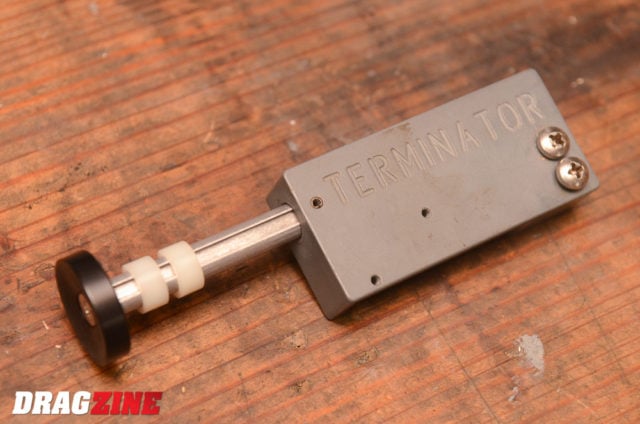
The Terminator with a pair of shims installed. The Terminator provides up to .045-seconds of delay with all of the shims removed.
For Ellison, a former NHRA U.S. Nationals Super Stock champion who has driven and won in virtually every sportsman category there is, the Just-N-Time button came as a result of his own experiences with other buttons on the market.
When I won Super Stock at Indy, we had the car slowed down and everything else to match my spot on the tree, and I was almost red every run. We needed a better way to slow down the transbrake button so that we could speed up the car. – Lynn Ellison
In an effort to get away from adjusting tire pressure, engine launch RPM, the shocks, and other factors that all effect performance, Ellison and Lemen set out to offer a better mousetrap. The result was the Just-N-Time button, which utilizes a set of user-replaceable, external springs and shims to dial-in a range of delay from .001 to .080-seconds (a full tenth is possible, but Ellison explains the weak spring used to achieve this is highly susceptible to mounting position, requiring it to be mounted virtually level), all accurate to within .002-seconds. The Just-N-Time comes packaged with six colored springs, all with different degrees of tension, which in addition to the adjustability of interchanging the springs themselves, are further adjustable by using the four different mounting holes on the button. Then, to really fine-tune the delay, three shims are included that install onto the button shaft. All told, Ellison says there are over 1,000 different combinations that can be had, making it possible to dial-in your reaction time on any day, at any track, and in virtually any car.
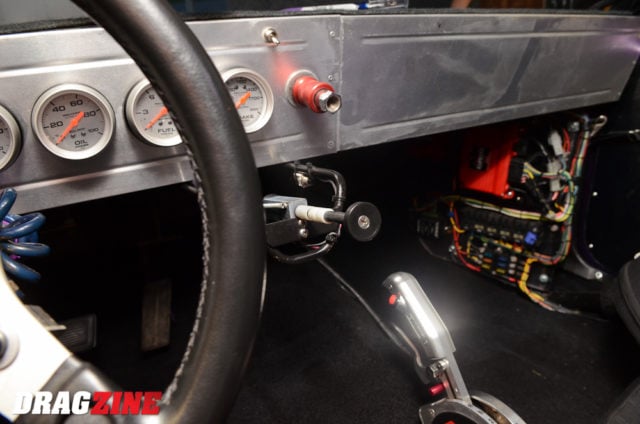
The “5-0” button from Biondo Racing Products was a hot-ticket item in no-box bracket racing for several years until it was outlawed by the NHRA. The 5-0 sports 5-inches of total travel, which is outside the NHRA’s mandated 3-inch limit in Super Stock and Competition Eliminator.
Ellison and Lemen, having electronically tested every combination, provide a “cheat sheet” for racers that outlines the spring and shim combinations that arrive at a specific amount of delay. Thus, if you show up at a new track and you’re .030 on the tree, it doesn’t take a day or trial and error to adjust the .025-.030 out of your reaction time that you need.
In Practice
What this button does is get your car where you can feel confident that if you can see the light the same, you can let go and manipulate the car and not have the driver have to adjust his or her spot on the tree. – Lynn Ellison
“What this button does is get your car where you can feel confident that if you can see the light the same, you can let go and manipulate the car and not have the driver have to adjust his or her spot on the tree,” Ellison explains. “Racers are finding that if the rollout is different at a track and they go red on two time runs, they can go back and adjust the button and now they’re .010 on the tree again like they want. It makes life on the bottom bulb better than anything before.”
As Biondo shares, “for bottom bulb racers, delay boxes aren’t legal, and there are ways of adjusting your reaction time with RPM and tire pressure, but when you do that, you start effecting the performance of the car, too. And it’s a lot easier to adjust the button in the car right next to you. If you’re sitting in the staging lanes and you’ve got cloud cover all of a sudden and you’re coming off a very close to perfect light and you want to slow yourself down, you can do so without getting out of the car. To me, it is a must for bottom bulb racers, because as important as reaction time is in bracket and index racing, being able to make adjustments is a big deal.”
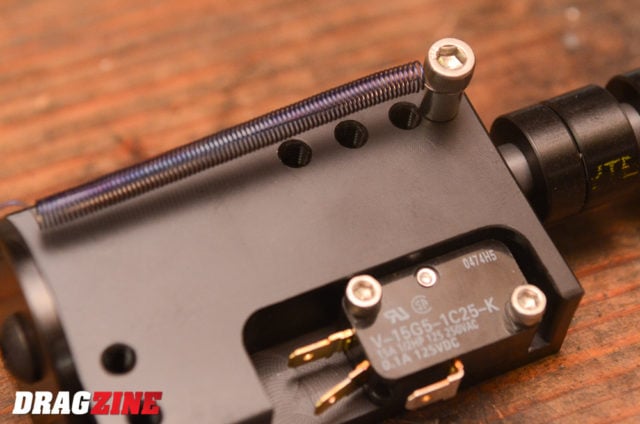
From this angle, you can see the adjustable mounting points available on the underside of the Just-N-Time button. The company provides six different springs, all of which can be moved to any of the four positions to alter the tension and the return rate of the button. Combined with the shims on the button shaft, over 1,000 different combinations are possible to dial-in your reaction time.
“A lot of the footbrake guys will complain about having to race guys with an adjustable button, because they think it makes you go .00 on the tree every pass. Some even think you can leave on the top bulb, but you can’t. Each bulb is half a second, and the buttons have, at most, a tenth of delay in them.”
It would be beneficial to have a delay box and be able to adjust it down to within .001-second, but it’s pretty consistent. It is a delay device, but it is definitely not a delay box. – Eric Paul
Both Paul and Ellison agree that, given pinpoint accuracy by the driver, the buttons can be nearly as exact as a delay box in fine tuning reaction time adjustments.
“It’s pretty close. It would be beneficial to have a delay box and be able to adjust it down to within .001-second, but it’s pretty consistent. It is a delay device, but it is definitely not a delay box.”
Use In Heads-Up Racing
Although there’s always the potential for red-lighting amongst any form of drag racing, the .400 pro tree common in heads-up racing makes fouling out more a result of over-anticipation on the part of the driver than it is the quick reactions of the car (Pro Stock Motorcycles are historically an exception to that). As such, these buttons aren’t a hot-ticket item for heads-up racers, but Ellison admits they do get interest from heads-up racers in their product.
NMCA racers and guys like that are using this button and setting it where you can hit the tree as hard as you can with your car as fast as you can… – Lynn Ellison
Ellison counts NMCA, NMRA, grudge, and outlaw-style racers among their customers currently using the Just-N-Time. 2015 NHRA Competition Eliminator world champion Craig Borgeouis credits the button for his title run, as he was able to dial performance back into his dragster that he’d previously had to tame down for reaction time purposes, picking him up about half a tenth to sixty-feet and in turn further under the index at the finish line.
As always, racers will be racers, and that means continually striving to solve problems and improve their performance, and that’s precisely what these bottom bulb buttons are: some good old-fashioned thinking outside the (delay) box. As the many championships and big-buck titles earned on these buttons have proven, their relatively small cost in the grand scheme of things are a significant difference-maker, and if you don’t have one, you’re probably losing the stripe to someone that does.



